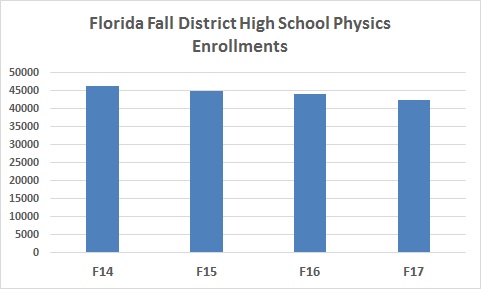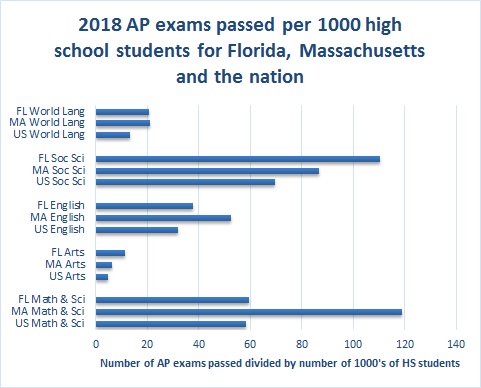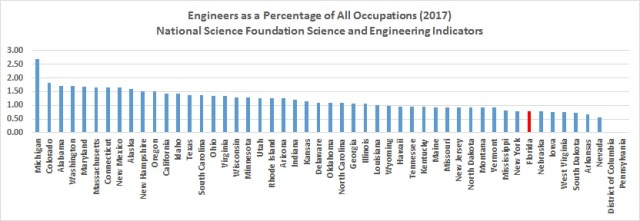The sciences that form the foundation for engineering, meteorology and similar disciplines continued to decline in Florida’s public high schools during the 2017-18 school year. Physics enrollments declined 8% over three years, while chemistry enrollments declined 9% in just two years. Teacher shortages and the lack of awareness by parents, students, counselors and administrators about the importance of these subjects for college STEM majors may be contributing to the decline.
The physics and chemistry enrollment data in the two plots below come from the Florida Department of Education web site.


We hope to have enrollment numbers for Fall 2018 early in the new year.
The number of middle school students passing Florida’s Algebra 1 end-of-course exam continued to grow in the Spring of 2018. Students who pass Algebra 1 in middle school are on track to take at least one year of calculus in high school, giving them strong preparation for college majors like engineering, physics and computer science.

But the opportunities to learn Algebra 1 in middle school are not the same for all students. In some school districts, black middle school students took and passed Algebra 1 students at much lower rates than other students. While Collier and Orange Counties were broadly successful with their middle school Algebra 1 programs and did nearly as well with their black students, some other school districts like Sarasota and St. Johns did a much poorer job with their black students than they did with other students.

Once again, the Algebra 1 EOC results come from the Florida Department of Education web site – this time the department’s EdStats portal.
Once all of these students who passed the Algebra 1 EOC move on to Algebra 2, Precalculus and Calculus courses, they’ll need teachers with Florida’s Math 6-12 certification. The problem is that there are fewer and fewer individuals taking and passing the certification exam – and entering the teaching profession (see graph below). Solving the shortage of teachers in math and science (and other fields) should be policy-makers’ highest priority.
The FTCE results are from the Florida Department of Education’s report on this subject.

Florida’s educational leaders love to brag on the success the state’s high school students have on Advanced Placement exams. And those leaders are right to a point – Florida students are national leaders on AP social science exams and do well on exams in English, arts and world languages. But on AP math and science exams, Florida is merely average. And average is a bad place for students to be in 2018.
In the graph below, Florida’s performance on AP exams is compared to national rates and the nation’s leader, Massachusetts. The data come from the College Board’s AP 2018 Performance and Participation page.

AP exam results in calculus, computer science and physics also tell us something important about the pipeline to careers in these fields. The red bars in the graph below shows the percentages of black students, Hispanic students and girls in Florida’s K-12 schools. The green bars show the percentages of AP exam passers who are in these groups. Girls are significantly underrepresented in computer science and physics. Black students are tremendously underrepresented among the AP exam passers in those subjects.

These AP data have consequences. In 2015-16, women earned 20% or less of the bachelors’ degrees in computing, engineering and physics awarded in the State University System. Only 7% of the engineering bachelors’ degrees in the system were earned by black students. There was a significant shortfall in Hispanic bachelor’s degree grads in math and physics as well. These data came from the Florida Board of Governors web site.

Florida’s poor performance in preparing high school students for college STEM majors is reflected in the state’s workforce. The state ranks 39th among states and DC in the percentage of the employed workforce that are in science and engineering occupations. In engineering, Florida is ranked 43rd. Data are from the National Science Foundation’s Science and Engineering Indicators.



Pingback: Bachelors’ degrees in engineering, computer science and physics are among the surest routes to economic security in America and more Florida students should have access to them: What I’ll be doing in 2019. | Bridge to Tomorrow
Pingback: Orange County Public Schools desperately wants to give every student access to careers in engineering, physics and computer science. Here’s how I know. | Bridge to Tomorrow
Pingback: Black students in Florida’s STEM pipeline: Among middle school students who passed Florida’s Algebra 1 end-of-course exam this spring, black students are significantly underrepresented. But some districts are doing better on this issue than ot